How to root hibiscus from cuttings, other propagation methods

It is difficult to find a person who has never heard of such a plant as hibiscus or, as it is often called in everyday life, Chinese rose. However, few people know how to root hibiscus from cuttings correctly, which is extremely important when propagating.
Content:
- How to propagate a hibiscus flower: methods
- Selection and preparation of cuttings
- How to root tree hibiscus from cuttings in the ground
- How to root a hibiscus cutting in water
- Rooting hibiscus with cuttings in vermiculite
- Cuttings of herbaceous hibiscus
How to propagate a hibiscus flower: methods
Chinese rose is demanding when choosing a place of growth, so it is important to provide the shrub with a sufficient amount of light, but at the same time protect it from direct sunlight.
If this is not done, burns may appear on the foliage. In general, drafts are unacceptable - they destroy the plant and temperatures are too low.
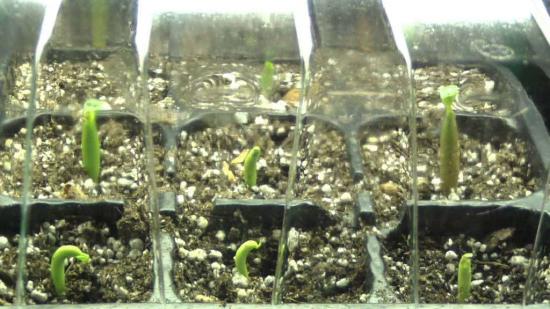
Despite the demanding nature of hibiscus, there are quite a few methods for planting it, including those listed in the table.
| Seeds | The method requires special skill and is recommended only for experienced gardeners. |
| Dividing the bush | To do this, it is enough to divide the adult bush into parts so that each has a root. |
| Layerings | By digging a branch for its subsequent rooting. |
| Cuttings | The most common method, even a novice gardener can handle it. |
Both with young seedlings and with mature plants, it is important not to forget that Hibiscus is very demanding when it comes to watering in the summer. By autumn, the amount of moisture should be reduced, and in the cold season - reduced to a minimum.
It is important to prevent the earthen ball from drying out, as this can negatively affect flowering and lead to leaf fall.
Selection and preparation of cuttings
Depending on the variety, hibiscus may vary in color and size. But all of them lend themselves well to propagation by cuttings, subject to certain rules. First of all, it is important not only to plant and root it correctly, but also to choose it.
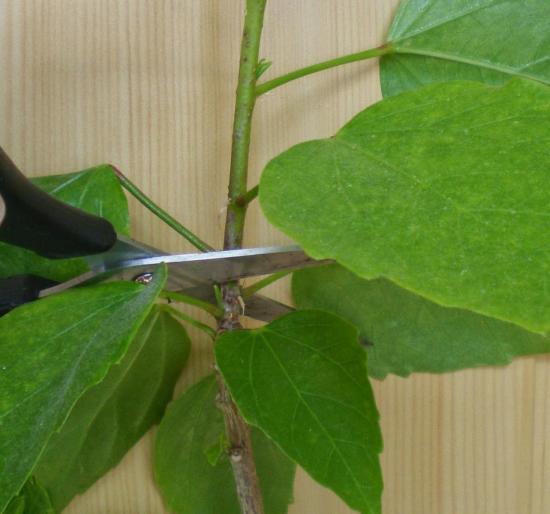
Thus, branches with at least several internodes are suitable for propagation. However, it is also not recommended to take a branch that is too large.
You need to cut the cutting with a sharp, pre-cleaned knife, and then sprinkle the cut area with crushed charcoal to disinfect it. Then it can either be sent to damp sand for germination, or placed in water.
How to root tree hibiscus from cuttings in the ground
Hibiscus has a powerful root system, so the container must match the size of the seedlings. In addition, it is important to prepare the soil mixture in advance so that the plant initially develops in loose soil favorable for rooting.
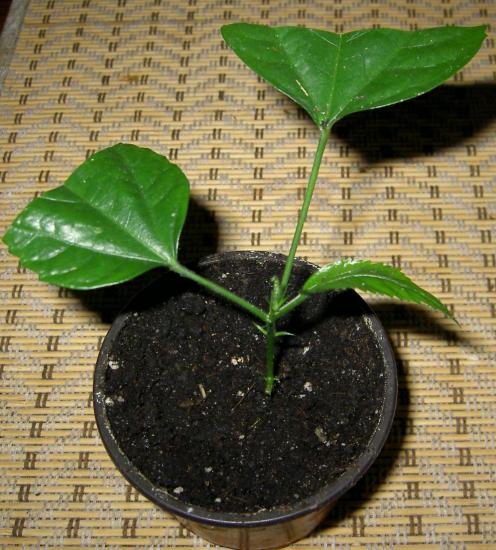
The optimal soil mixture is:
- Leaf and turf soil in two parts;
- Sand is one part.
Before planting, it is recommended to pour boiling water with a solution of potassium permanganate into the soil mixture for disinfection.
After the mixture has dried, fill the pot with it so that the soil covers a little more than half of it, a few centimeters of sand on top of it and stick the roots into the substrate.
To stimulate growth, it is recommended to cover the top of the seedlings with polyethylene or a jar to create greenhouse conditions. It is important not to forget about watering, to moisten the substrate as it dries. After a few months, the sprouted plant can be transplanted to a permanent place of growth.
How to root a hibiscus cutting in water
Rooting Chinese roses in water is a much simpler and faster method. To do this, just prepare a jar of water in which you need to dissolve several tablets of activated carbon.
It is important to choose dark-colored jars; if you don’t have one at hand, just paint the jar with dark paint or wrap it with something to darken it. This activates root growth.

After preparing the container, place the cut branches in water and wait. It is not recommended to change the water; it is enough to systematically add it.
In this case, the water must be settled.
After the roots appear and grow to 5 mm in length, begin planting. This is the optimal size, sufficient for the flower to grow independently in the soil.
Some experts call the weakness of young seedlings a slight drawback of this method. However, do not worry, the survival rate is still quite high.
Let's watch a video on how to properly root a hibiscus from a cutting:
Rooting hibiscus with cuttings in vermiculite
In addition to water and a soil mixture, to germinate Chinese rose seedlings, gardeners use a porous material that has good air and water permeability - vermiculite.
This material ensures rapid penetration of moisture with its uniform distribution, which contributes to the fastest possible rooting of any flowers.
A large number of microelements in the material activates germination processes, with strong roots appearing, and seedlings have a high level of survival when transplanted to a permanent place of growth.
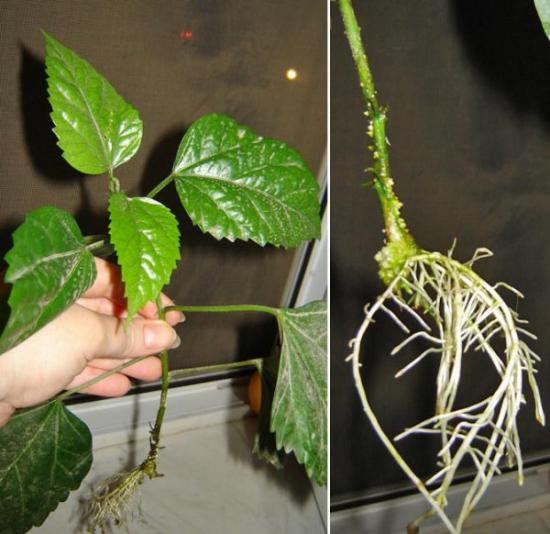
Another advantage of vermiculite is its sterility; unlike soil and sand, bacteria and fungi cannot multiply in it.
To ensure successful rooting of cuttings, it is recommended:
- Prepare a container with good drainage by filling it with vermiculite of fraction 1-2 mm;
- Water, saturating the substrate with water, then wait a little so that excess flows through the drainage holes;
- Place the harvested cuttings in vermiculite and lightly compact the seedling circle;
- Cover the container with film or a jar and place in a warm, dark place. In this case, it is important to systematically shake off large drops of condensed moisture from the jar or film so that they do not fall on the leaves of the seedlings;
- After the plant takes root, it is recommended to begin a period of adaptation to new conditions. To do this, it is necessary to systematically remove the covering and ventilate the seedlings;
- After a week or two, you can begin planting seedlings in a permanent place of growth.
Vermiculite compares favorably with previous materials for germinating seedlings. It does not retain air or water and, importantly, cannot cause seedlings to become sick or damaged by harmful fungi.
Cuttings of herbaceous hibiscus
Herbal hibiscus is a hybrid variety; cuttings can only be taken in early summer when shoots are growing. This way, before the first cold weather, the seedlings will have time to take root and the likelihood that the flower will survive the winter increases.
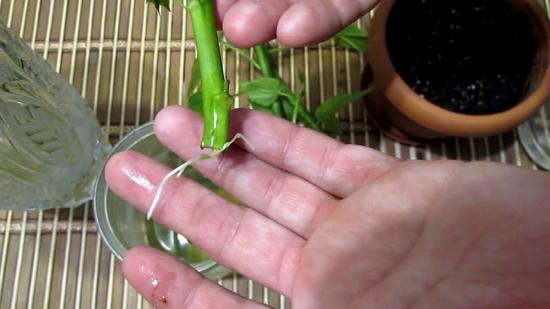
In order for cuttings to be successful, it is recommended:
- On the day of planting, in the morning, water the bush generously so that the water saturates the earthen ball. In the evening, you can proceed directly to separating the sprouts. It is recommended to choose young shoots that grow at the base of old bushes;
- Do not cut out the shoot, but pull it out to the side. The result should be a seedling with root rudiments or a white tint at the base;
- Cut off the top of the sprout, leaving some foliage;
- The base of the seedling is sprinkled with root;
- The hole for a new bush should be filled with a mixture of brown high peat, sand and charcoal. The mixture must be poured thoroughly;
- The cuttings are planted and covered with a cut bottle on top until rooting. There is no need to water additionally;
- It is recommended to remove the bottles for a few minutes every day. If it’s hot outside, you should additionally spray the seedlings;
- After two and a half to three weeks, rooting occurs. Now it’s time to start acclimatizing the seedling. To begin with, it is recommended to open it every day for ten minutes, gradually increasing this time, hardening the hibiscus. On average, complete adaptation to new conditions occurs within a week.
If the resulting plant seems weak at first, it can be tied to a stake. In this case, it is better to take a longer peg, for several garters.
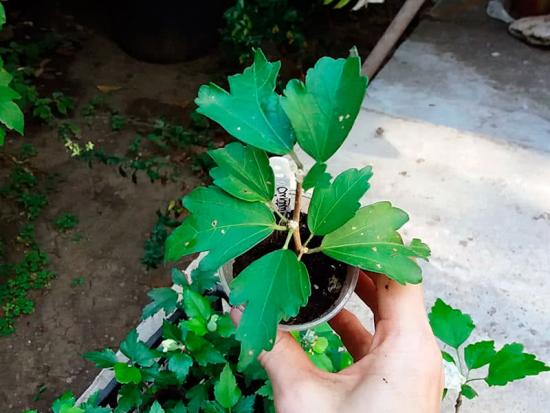
Reproduction of hibiscus at home is a painstaking task, but does not require phenomenal knowledge.
We invite you to watch a video about the propagation of herbaceous Syrian hibiscus by cuttings:
All it takes is desire, attentiveness and a few hours of free time to get several from one beautiful flower and then, perhaps, a whole greenhouse that will please the eye.


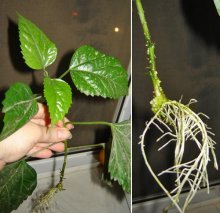
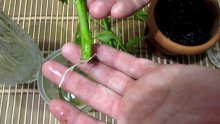
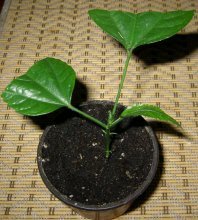

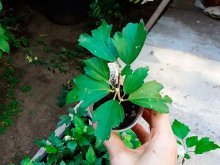
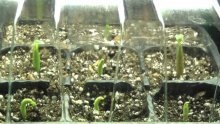


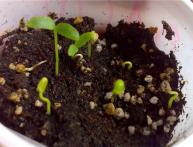





Comments
It is best to root hibiscus not in water or vermiculite, but in a soil mixture. After all, when transplanting a cutting with roots into a flower pot, the roots may break and the plant will not take root.